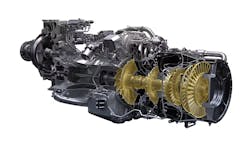P&W Canada, Jet Builder ATR Working on 100% SAF
In the latest step by the commercial aerospace sector to reduce carbon emissions, Pratt & Whitney Canada agreed to work with regional-aircraft builder ATR on an initiative to achieve 100% Sustainable Aviation Fuel (SAF) readiness for PW127 series engines by 2025. Their agreement will cover the new PW127XT engine that will power upcoming ATR aircraft.
ATR is a 50-50 joint venture of Airbus and Leonardo that supplies twin-engine turboprop aircraft for regional service, principally the ATR 42 and ATR 72 models – both of which are powered by PW127 engines.
“Our collaboration with ATR will be underway throughout 2023 and 2024 and builds on our recent 100% SAF test flight with Braathens Regional Airlines, which was an industry first for regional aviation,” stated Pratt & Whitney Canada’s Anthony Rossi, v.p. - Sales and Marketing.
“Alongside our efforts to continually enhance aircraft engine efficiency, SAF has a critical role to play on the journey to achieve the aviation industry’s goal of net-zero CO2 emissions by 2050,” Rossi continued. “While all Pratt & Whitney Canada engines have already been certified for 50% SAF blends for more than a decade, ensuring readiness to operate with 100% SAF blends in future will allow us to maximize their potential for decarbonization.”
SAF is jet fuel produced from waste oils derived from biological sources (e.g., cooking oil, other non-palm waste oils from plants, agricultural residue, or non-fossil CO2), or solid waste from homes or businesses (e.g., packaging, paper, textiles, food waste.) Currently, commercial aircraft are certified to operate on a maximum of 50% SAF blended with conventional jet fuel, though aircraft and jet-engine manufacturers have made commitments to increase the effective applicability of the alternative fuel.
All the major aircraft engine builders and aircraft OEMs have invested research and resources to prepare existing systems to operate on higher percentages – up to 100% – of SAF.
“We have recently demonstrated with our collaborators, Braathens Regional Airlines and Pratt & Whitney Canada, that ATR aircraft are SAF-ready,” stated Nathalie Tarnaud Laude, ATR’s CEO. “Now, we need to continue to join forces to increase SAF availability, as part of our common journey towards net-zero.”
